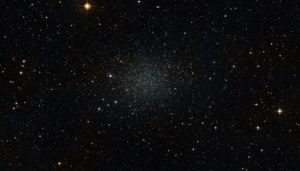A combo of Hubble and Gaia data reveal the distribution of dark matter in a tiny galaxy by tracking the galaxy’s stars.

ESA / Hubble / Digitized Sky Survey 2
Scientists have tracked the motions of stars in the Sculptor dwarf galaxy, which orbits the Milky Way roughly 300,000 light-years from Earth. The results, published in the December issue of Nature Astronomy, are exciting astronomers not for the stars themselves but for what the stellar motions trace: dark matter.
Davide Massari (University of Groningen and Leiden University, The Netherlands) and colleagues combined observations taken by the Hubble Space Telescope more than a decade ago with the first data release from the Gaia satellite, showing how 126 stars move along the plane of the sky (sideways, from our perspective). Combining these observations with previous measurements of the stellar motions along our line of sight, they obtain three-dimensional velocities. Finally, picking out 15 objects for which they have the best measurements, the team mapped out the unseen dark matter halo that guides the stars’ orbital trajectories.
The popular theory of “cold” (aka, slow-moving) dark matter says that the mysterious particles ought to gather at the center of a galaxy like the peak of a dark whipped cream. Nowhere should this effect be more visible than in dwarf galaxies — they’re dark matter-dominated and largely lack the sources that could confuse measurements, such as pulsars and supernovae. But results to date have had astronomers mired in what Massari and colleagues call “a longstanding unresolved debate.”
The new measurements show that the Sculptor dwarf galaxy might actually have the predicted peak of dark matter. But it hasn’t settled the debate: the sample of stars is small and concentrated at one location in the galaxy, and the authors acknowledge that the observations don’t rule out the non-peak scenario. Nevertheless, the observations show the power of Gaia observations — the next data release, due in April 2018, will include on-the-sky motions for a much larger sample of stars.
Read more about the result in the Hubble press release.
 1
1









Comments
Avraamjack
December 20, 2017 at 3:51 pm
Howdy,
I am a bit skeptical of the existence of dark matter:
.
__________ROTATING SPACE__________
.
Seems kind of obvious that was is thought of as dark matter is, in fact, galaxy sized graviton whirlpools.
As gravitons are emitted from the massive objects in a galaxy, they spread in all directions from those objects.
But mass drags space along with it, so the very mass of the galaxy also makes the galaxy’s space spin. Thusly, you have the framework for a whirlpool.
The gravitons, trapped in this spinning space, therefore exhibit an effect that appears to be a greater gravitational effect than the mass of the galaxy would indicate. This effect also explains the gravitational lensing of distant galaxies.
The mere effect of rotating space, by itself, would also provide the illusion of a greater gravitational effect. As the stars orbited the galaxy, they would, relative to the space surrounding then, not be moving as fast as they would appear to be moving. Effectively carried along, by the surrounding space, like a surfer on a wave, the star may appear to be moving too quickly to maintain orbit, relative to the viewer, but relative to the wave of space, it is moving far more slowly. The centrifugal forces that would affect the star, are relative to the surrounding space, not relative to the distant viewer.
Space rotating around a galaxy may also create an unexpected gravitational effect. Much like getting close to the edge of a whirlpool or the lift of an airfoil, there may be an effect of the spinning space itself which causes greater gravitational effect.
In summary: There is no dark matter. The illusion of excessive gravity is caused by the galaxy’s spinning space by itself or that same spinning space combined with a graviton feedback loop, essentially creating a galaxy sized graviton whirlpool.
Utterly key point: Stars do not orbit galaxies. Space orbits galaxies and carries the stars within that space along. Once you understand that, the relatively uniform appearance of so many galaxies makes perfect sense. You are looking at a whirlpool. Only where the velocity of the star exceeds the velocity of the space can you you say the star orbits, but most of the effect is from the rotation of space around the pole of the galaxy.
.
References: If small rotating objects drag spacetime around, an entire galaxy can spin it at much larger scale:
http://news.mit.edu/1997/blackholes
http://www2.csr.utexas.edu/grace/publications/press/04-10-22-rednova.pdf
You must be logged in to post a comment.
You must be logged in to post a comment.